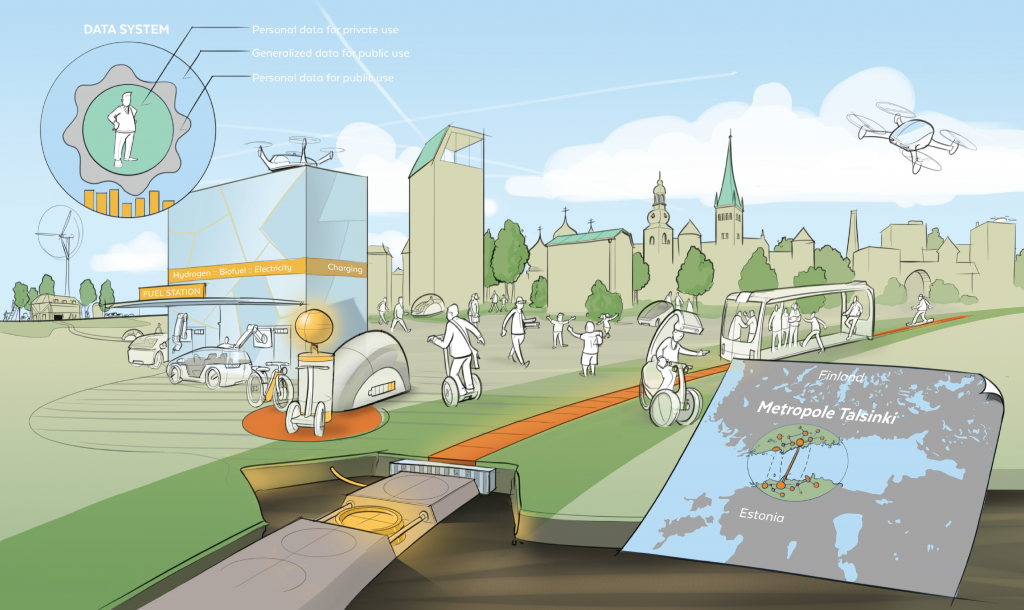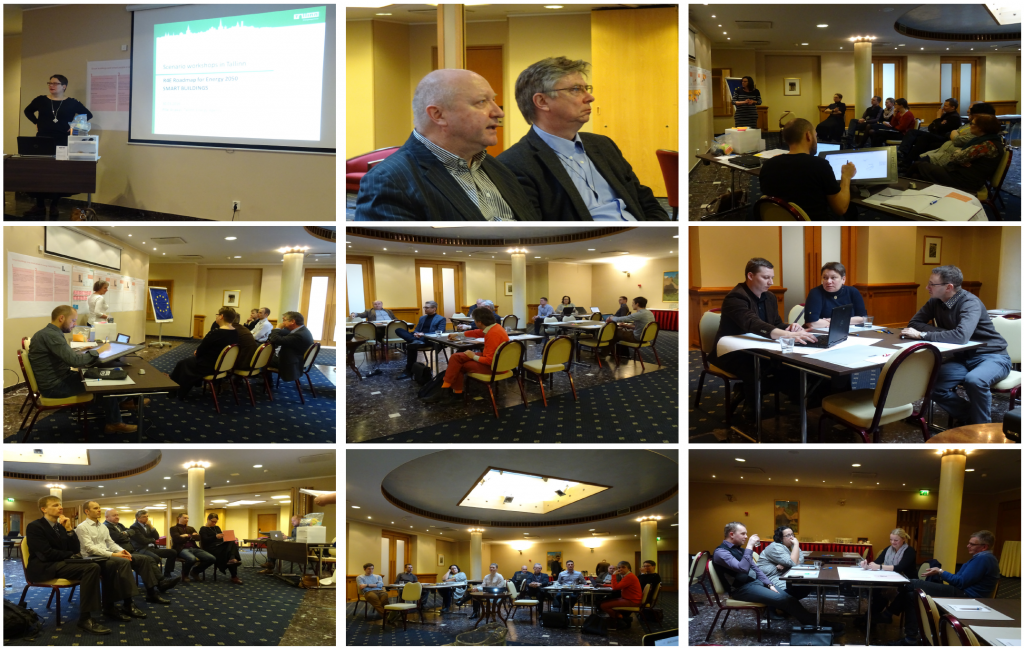Tallinn Vision Development 2050

Vision development for Tallinn 2050
The R4E project has completed the “Vision development” stage, which consisted of designing the services and characteristics that our cities should offer in the year 2050, based on the opinions and contributions of municipal experts of each city, their stakeholders, politicians and municipal managers. To better illustrate the process, images have been created that reflect the way our cities could look in 2050, including the services and characteristics agreed upon in the workshops for each of the project’s focus areas.
SMART BUILDINGS AND SMART PEOPLE IN ENERGY-NEUTRAL TALLINN 2050
In 2050, people in Tallinn value sustainable behaviour and renewable energy. They take individual responsibility for energy saving, and the remaining energy demand is affordable for all. Renewable energy sources such as heat pumps, biofuels and energy from the sea enable a CO2-neutral city.
All existing buildings have had a far-reaching renovation and modernisation, with respect for their historical heritage. All the energy systems are automated and connected. Smart materials and equipment contribute to an energy-neutral city.
Integrated and flexible city planning values an energy-efficient smart city. Planners have the knowledge and awareness to work at an integrated system level. Their work takes into account all relevant issues, and provides the flexibility to adapt to changing situations. These policies are implemented through specific, integrated district plans.
What characterises the city of Tallinn in the focus areas of Smart Mobility and Smart Buildings and the elements of the desired future scenario are:
1. Distributed services
Services in Tallinn are distributed in decentral hubs around the city, with logical clusters of services according to the needs of the people in the area. The hubs are connected by free (self-driving) public transport and light traffic highways for safe and comfortable commuting by (e-)bike. Households enjoy sharing facilities for sauna, laundry and mobility. The newest technologies for generating electricity and charging devices are widely available.
2. Prefab building modules
Buildings are constructed and renovated with prefab building blocks using state- of-the-art, sustainable and energy-efficient materials. Smart technical systems are integrated in the modules, so technical rooms are small. The blocks allow flexible additions to buildings to add extra space or change functionalities (e.g. accommodating changes in schools). New technologies such as 3D printing allow high flexibility and custom design for architectural freedom.
3. Smart public services
Public services (home care, medical care, sports training, education etc.) are remotely accessible. Smart solutions enable service delivery at home (e.g. measuring blood pressure). An integrated system (like a web portal) offers access to services from all companies, and makes it easy to search for and find the right ones. The use of artificial intelligence allows tuning to individual needs, and providing useful services and incentives (e.g. comparing ecological footprints).
4. Flexible use of public buildings
Public buildings (schools, churches, theatres) in Tallinn are used intensively. People can book rooms, buildings and equipment for different purposes through an online portal, e.g. using schools in the evening for computer training for adults, yoga classes in a gym or office rooms for short-term rental by start-ups. The buildings are showcases of energy efficiency and provide energy for the community (e.g. as carriers of PV panels for shared use) and energy education.
5. Sophisticated renovation
All buildings are deeply renovated with the newest technologies for energy efficiency, and are connected to CO2-neutral district solutions for heating and electricity generation. Flexible funding schemes and incentives (e.g. tax breaks or prizes) drive people to achieve the highest saving with the best indoor climate through renovation and behavioural change. Local government demonstrates and encourages good practice, and provides temporary housing during renovation.
SMART MOBILITY ENABLES AN ENJOYABLE LIVING ENVIRONMENT IN TALLINN 2050
In 2050, citizens in Tallinn enjoy an attractive, clean and quiet living environment that encourages sustainable behaviour. The cityscape is dense, so all services are within easy reach or are provided in the home. More public space is allocated to living, and less to motorised transport.
Smooth, seamless public transport connects all the city areas. Smart planning is used to respond dynamically to the changing demand for the transport of people and goods. The transport and ticketing systems around the Baltic Sea are integrated in a way that is simple, comfortable, affordable (free), clean and fast.
Planning and decision-making processes are based on open collaboration that includes different views and knowledge sources. Tallinn is recognised as a front-runner in openness. Citizens are aware of their roles, and actively take part in making decisions that influence their living environment.
1. Human scale squares
The city’s streets and squares are designed around people. The urban environment is safe, attractive and suitable for a wide range of social interactions. The design of the spaces, with an extensive network of cycle tracks and pedestrian-only areas, gives clear priority to walking, cycling and new modes of personal mobility like self-driving bikes and wheelchairs. This ensures easy accessibility for all citizens.
2. Vehicles on renewable energy
All vehicles, bikes and cars are shared, self-driving and adaptive to the available infrastructure. A shared electrical vehicle system provides the city with renewable energy storage by allowing access to the vehicle batteries. The smart infrastructure collects information from the vehicles for the central system, through which users receive relevant information such as traffic signs, traffic information and navigation suggestions.
3. Innovative public transport
Different energy-efficient mobility modes include more flexible infrastructure, like trams with magnetic tracks for midrange distances between the neighbourhoods. The non-disruptive infrastructure allows shared use by all vehicles. For longer distances, an integrated public transport system covers Estonia, Scandinavia and the Baltic States, based on superfast and energy-efficient solutions.
4. Metropole Talsinki
Tallinn and Helsinki together form one big metropolis, with the advantages of economy of scale. This also provides advantages for direct goods logistics connections to Helsinki and beyond. Tallinn is a key hub between mainland Europe and Helsinki. The airport in Tallinn and a high speed transportation system provide fast, comfortable and reliable links for people and goods, and have a positive impact on the labour market and economics.
5. Data system
The ‘Smart Department’ of Tallinn collects and analyses real-time information for use in smart algorithms that optimise the system based on people’s needs. The system is used for decision-making and planning purposes, such as parking & charging of e-vehicles and use of public transport lines. All kinds of applications use the resulting information to provide users with valuable services.
All these ideas and input have emerged from the participatory workshops that have taken place in the city of Tallinn and whose images can be seen below:



Leave a Comment